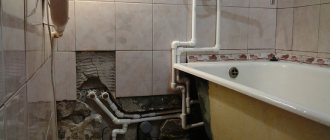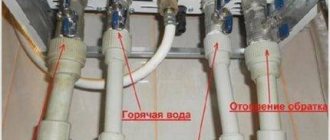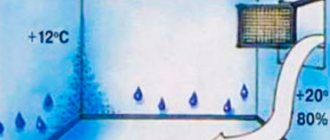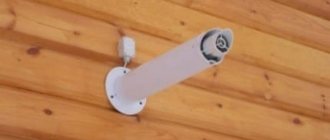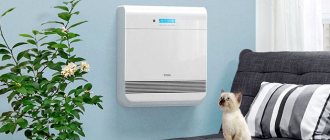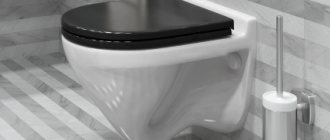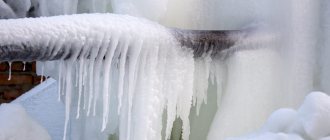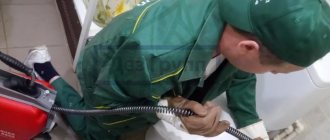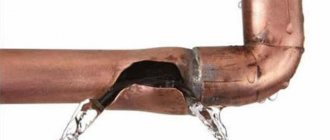Modern man is very thermophilic. If you, our dear reader, have your own home, then you have to solve the problem of heating it yourself. But modern heating equipment is different from the simple stoves and fireplaces of the past; Along with an increase in efficiency, the complexity of the design increases and the maintenance of units becomes more complicated.
When modern boilers, stoves and fireplaces operate, condensation inevitably forms in the chimney.
What is condensate?
Whatever type of fuel you use, you burn hydrocarbons. Coal, coke, firewood, fuel oil, gas, pellets - everything consists of hydrogen and carbon with small admixtures of sulfur and some other chemical elements. Any fuel also contains a small amount of water - it is impossible to completely remove it. During combustion, they are oxidized by atmospheric oxygen and the output is water, carbon dioxide, and other oxides.
Sulfur oxides at high temperatures react with water and form very aggressive acids (sulfuric acid, sulfurous acid, etc.), which also enter the condensate. A few other acids are also formed: hydrochloric, nitric.
Why is condensation dangerous?
There are two immediate dangers when condensation forms:
- when condensate freezes in the form of ice at the mouth of a pipe or deflector, the cross-section of the pipe overlaps until it is completely closed - as a result, the draft decreases, the draft may overturn (reverse draft), combustion products (carbon dioxide and carbon monoxide) will enter the living room and cause severe poisoning of people; hot gases may cause a fire.
- in very large quantities, the liquid can extinguish the fire, for example, in a fireplace - with a direct-flow pipe).
Consequences of condensation in pipes
An aggressive acidic environment, collecting on the walls of a chimney, leads to its rapid destruction - acids corrode the steel, corrosion occurs - the metal quickly rusts and “burns out”. Brick pipes are also destroyed by acid condensation.
In addition, condensate flowing into the boiler furnace also destroys the heating unit (and in very large quantities it can extinguish the fire in the furnace).
A large amount of moisture settling on the walls can also lead to unpleasant consequences:
- moisture settling in the upper part of a brick chimney leads to its getting wet and constant freezing and heating - this leads to the rapid destruction of such a pipe;
- condensate flowing into the boiler furnace also destroys the heating unit;
- When a steel pipe “burns out,” moisture gets into the insulation, freezes and thaws—the pipe also collapses very quickly.
The photo below shows the consequences of repeated freezing of a brick pipe.
A wet spot appears on the pipe
Ordinary heats his nice, solid house with a gas boiler (temperature on the boiler is +45 degrees), the boiler outlet is 150 mm, and the chimney is designed like this: the asbestos-cement duct is also 150 mm, the cross-section of the pipes is slightly oval, “it was not possible to achieve tightness.” The chimney is filled with expanded clay concrete. The channel from the gas boiler goes into the pipe along with the same channels from the gas water heater, kitchen ventilation and boiler room ventilation.
One miserable morning on the eve of the New Year, a pipe about eight meters high appeared wet spots on both sides. Ordinary wrote with concern about his suspicions of condensation.
Regular FORUMHOUSE User
I suspect that the wet spots on the pipe are condensation, although I really want to think that I’m wrong. The worst thing is that the rafter beams inside the room get wet. They were wet from the mineral mat between the pipe and the rafter.
Reasons for the appearance of condensation in the chimney pipe
The exhaust gases contain water and other liquids in the form of steam. When gases are cooled, the steam becomes supersaturated, water collects in droplets and tends downwards - this is the main reason for the appearance of condensation. In a flow of hot gases, this process occurs near the colder walls of the chimney - and it is there that drops of liquid settle, forming condensation.
When considering the reasons for the appearance of condensation, it should be borne in mind that there is no smoke without water vapor; the presence of liquid collecting on the walls of the chimney cannot be avoided.
Reasons for the increase in the amount of condensing liquid in chimneys:
- uninsulated chimney, especially from single-layer galvanized pipes;
- the pipe is too long - significant cooling of the smoke occurs in the upper part;
- low exhaust gas temperature. This is especially true for modern units with a heat exchanger for connecting the heating system. It is desirable that the temperature of the gases leaving the furnace head be at least 100 °C;
- a large difference between the temperature of the ambient air and the exiting smoke;
- raw fuel (especially firewood);
- narrowing of the hog's clearance due to soot deposits and, as a result, a decrease in traction;
- low combustion temperature with incomplete combustion of fuel due to insufficient supply of fresh air, which leads to low smoke temperature and low draft;
- design flaws of the chimney - the presence of horizontal and inclined sections (exceeding the permissible standards of 2000 mm horizontal projection); discrepancy between the cross-sectional area of the channel and the design area (it is bad to both reduce and increase the cross-section);
- the ingress of precipitation in the absence of a deflector or cap increases the amount of liquid in the chimney channel;
- Rough walls inhibit exhaust gases more and collect more condensate than smooth ones.
How to fix the problem?
Even if you fulfill all the requirements when constructing a chimney, condensation will not be completely avoided. In a finished design this is even more impossible. But the problem can be solved by getting rid of the condensate that has already formed, reducing its concentration and minimizing the destructive consequences:
- Use dry fuel only. During combustion, less moisture will be released, soot formation will be reduced, in addition, such fuel produces more heat at lower costs.
Important! This method will not help when using a gas boiler, since it is impossible to reduce the amount of water vapor released during the combustion of natural gas.
- If the chimney is made of hygroscopic material, lining is used. A stainless steel pipe is laid inside the shaft, which absorbs the effects of aggressive substances. The sleeve will solve another problem - it heats up faster than brick or asbestos cement, which means drops will not form at the very beginning of the chimney.
- Insulating parts of the pipe located outside the heated room will help reduce the temperature difference. The smoke will cool more slowly, most of it will have time to disappear along with the condensation steam. For this purpose, thin steel pipes are wrapped with heat-insulating materials or hidden in an additionally constructed brick shaft.
- To improve draft, you should clean the chimney and eliminate any damage to the integrity of the pipe. This will facilitate the removal of combustion products and protect the system.
- To prevent rain and debris from entering, the top of the chimney is equipped with a cone-shaped nozzle - a deflector. It does not let sediment inside and also improves traction.
- A condensate drain should be installed at the beginning of the chimney and at bends in the structure. Mount it in such a way that it is easy to empty when filling.
We recommend that you read: Rules for calculating and installing a truss from a profile pipe
Ways to get rid of condensation
It is impossible to completely eliminate condensation. If you think that “in the past, stoves were heated for centuries and there was no condensation,” then you should keep in mind that now the fuel is burned almost completely, the efficiency of heating units is greater than that of more primitive models of wood stoves and fireplaces of past centuries, the temperature of the flue gases is lower – hence the larger amount of aggressive liquid in the chimneys.
It is possible to achieve such operation of the equipment and pipe design that almost all the condensate will be carried away into the atmosphere by very hot smoke - but it will also carry away a considerable share of heat and your money.
But all is not lost - measures can be taken to reduce the amount of condensed liquid
Insulation of the chimney channel
Alpha and omega chimney devices. Any chimney must be insulated all the way to the top. It is also recommended to additionally insulate old brick pipes above the roof and in the attic.
An uninsulated chimney has no right to exist at all.
Pre-drying of fuel
Firewood needs to be dried! First, under a canopy or in a spacious, ventilated barn, the optimal drying period is one and a half to two years. Finely chopped firewood dries faster. Before use, let them sit for a week or more in a warm, dry room. Constantly burning wet wood will result in large amounts of moisture entering the smoke, wasteful wood consumption, incomplete combustion and the release of large amounts of soot (and the need for more frequent cleaning of the smoke duct).
Coal, peat - do not wet. Bring it into the room in advance, let it warm up and dry out the moisture that has settled on it. Pellets, briquettes - protect from getting wet, store in a dry, warm room.
Choosing the right fuel
Firewood, pellets, briquettes (especially firewood) initially have higher moisture content than firewood or fuel oil. But it is more reasonable to choose the type of fuel for a heating unit, based on the parameters of fuel cost, availability in your area, and the need to automate the heating system.
Chimney cleaning
The smoother the internal surface of the smoke channel, the better the draft and the more moisture will “fly into the chimney”. Therefore, the chimney should be cleaned of soot regularly, without waiting for the draft to deteriorate - at least twice a year. Cleaning methods - mechanical or chemical - are not of fundamental importance.
Different types of fuel produce different amounts of soot. For example, for a gas boiler the amount of soot generated is minimal, for a coal furnace it is maximum.
Cleaning a chimney from soot is a completely affordable task to do yourself. In our video you will see all the intricacies of chimney cleaning.
Using a steam trap
What to do if condensation flows along the walls of the chimney? Install a container to collect condensate. This is an absolutely necessary measure in modern heating systems. Condensate drain - a stainless steel container for collecting condensate, mounted in the lower part of the vertical channel, below the outlet channel or pipe of the heating unit, with access for emptying it. Sometimes a permanent drainage of condensate from the tank into the sewer is arranged. Modern metal “sandwich systems” and ceramic pipes offer ready-made sections for mounting such containers.
Old chimneys should also be modernized by installing a condensate trap in the lower part.
The Ordinary enters the new season triumphantly
In the new heating season, the chimney on the roof of Ordinary’s house looked simply gorgeous. The chimney insert solved all the problems. It was quite an expensive pleasure, but it was worth it. Of course, you might not have encountered this spot on the pipe in your life at all, if everything had been done correctly right away. Ordinary generally says that now he would not mess with expanded clay concrete, but would make a sandwich, which allows you to ensure tightness, but - “I knew If I could fall somewhere, I’d lay down some straw.”
Warmth and traction to everyone!
On FORUMHOUSE you can read an article that warns against deadly mistakes when installing a chimney. Find out whether it is expensive or not to heat a house with gas cylinders: choosing a gas convector; cheap heating using liquefied gas; calculation of gas consumption. Watch a video on how to clean a chimney yourself using a basic set of tools that are found in any home.
Subscribe to our Telegram channelExclusive posts every week
Preventing condensation
Basic preventive measures to reduce the amount of condensate:
- even at the design stage - compliance with all standards for the installation of a chimney system;
- installation of a chimney without deviations from the project;
- modernization of existing pipes (the channel can be protected by inserting stainless steel liners; insulation);
- enhancing draft by all available means - installing deflectors, smoke exhausters, rotary turbines; reliable air supply to the heating unit;
- regular pipe cleaning;
- use of dry fuel.
Chimney design requirements
Requirements for the design of chimneys are determined by SNiP 41-01-2003.
Primary requirements:
- the height of the channel should not be less than 5 m;
- the height of the pipe above the roof is at least 1 m for a flat roof;
- the height of the pipe with a pitched roof is determined depending on the ridge (with a distance from the ridge to the head (horizontally) of 1.5 m - at least 0.5 mm; with a distance of 1.5 m to 3 m - flush with the ridge; with a distance more than 3 m - the angle between the horizontal and the line passing through the top of the pipe and the ridge should not exceed 10°);
- the length of the horizontal hog should not exceed 1 m;
- the sum of projections onto the horizontal of horizontal and inclined sections should not exceed 2 m, while the length of the vertical section increases by the same length.
